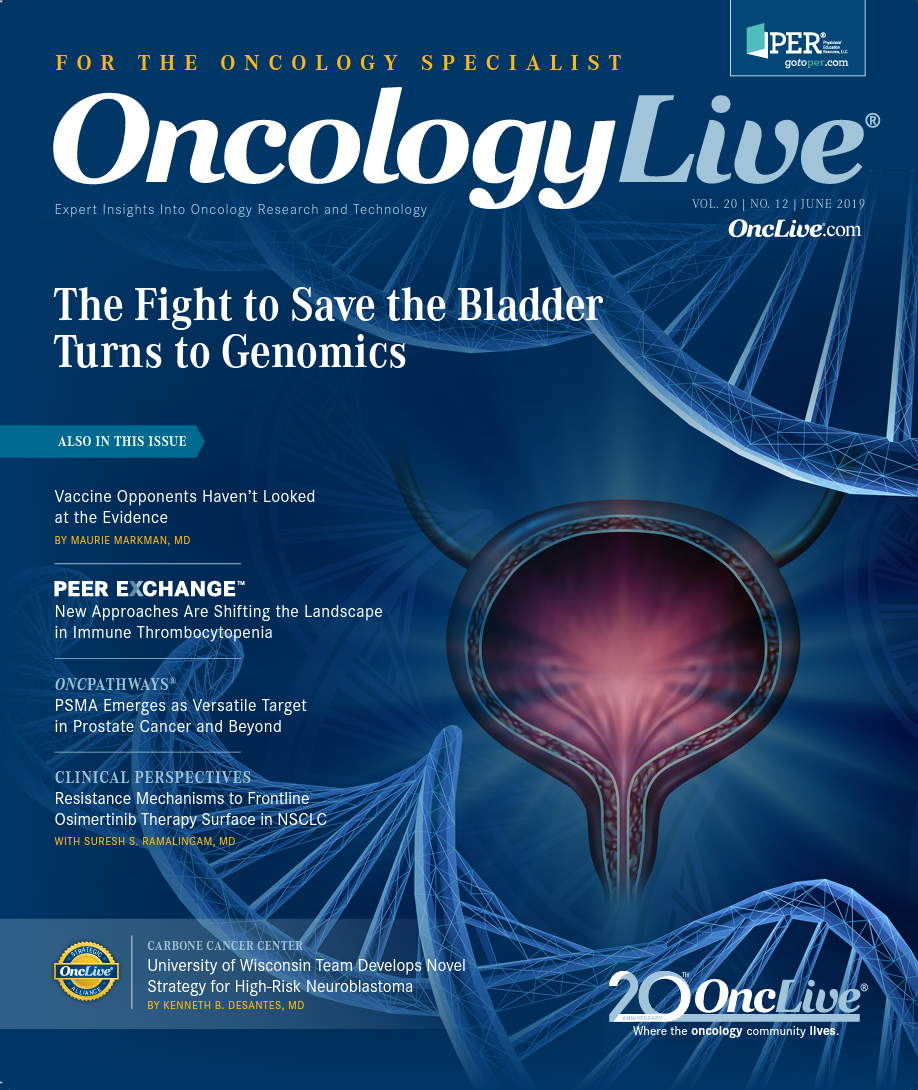Publication
Article
Oncology Live®
University of Wisconsin Team Develops Novel Strategy for High-Risk Neuroblastoma
Author(s):
Investigators at the University of Wisconsin American Family Children’s Hospital are developing a new approach to treating patients with neuroblastoma that has the potential to improve outcomes for patients whose disease has not responded to conventional therapy.

Kenneth B. DeSantes, MD
Professor in the Department of Pediatrics
Division chief of pediatric hematology, oncology, bone marrow transplant
University of Wisconsin Carbone Cancer Center and American Family Children’s Hospital
Madison, Wisconsin
Investigators at the University of Wisconsin American Family Children’s Hospital are developing a new approach to treating patients with neuroblastoma that has the potential to improve outcomes for patients whose disease has not responded to conventional therapy.
Our research team has initiated a first-in-human clinical trial for children with relapsed or refractory neuroblastoma utilizing the combination of an anti-GD2 monoclonal antibody (mAb) and haploidentical ex vivo activated and expanded natural killer (AE NK) cells (NCT03209869).
The goal is to develop new options for patients with the most challenging forms of neuroblastoma, which is the most common solid tumor of childhood occurring outside the central nervous system. Patients with this malignancy can be subdivided into risk groups based on their age, stage, and biologic features of the tumor. Children classified as having low- or intermediate-risk disease have an excellent prognosis (>90% survival), while patients with high-risk disease have significantly less favorable outcomes despite the use of aggressive combination chemotherapy, surgery, stem cell transplantation, and external beam radiation.
The incorporation of anti-GD2 mAb therapy into the treatment regimen for neuroblastoma is a relatively recent and exciting development in the field. In an early clinical trial, this approach resulted in a 20% improvement in event-free survival for newly diagnosed patients high-risk disease.1
Mechanisms of Action
The antibody presumably works by engaging cells of the innate immune system, such as NK cells and macrophages, via their Fc receptors (FcR), thereby bringing them in close proximity to the GD2-expressing neuroblastoma cells where cytotoxicity can be induced via the perforin— granzyme pathway or through engagement of death receptors on the tumor surface, such as TNF-related apoptosis- inducing ligand and Fas. This immunotherapy approach has proved effective in the setting of minimal disease, but not for patients with grossly measurable tumor.
In our trial, the antibody being used is the hu14.18-IL2 immunocytokine (IC). This molecule has several potential advantages compared with the commercially available anti-GD2 mAb ch14.18 (dinutuximab; Unituxin). First, the IC has been humanized and therefore contains less mouse protein, which should reduce the likelihood of eliciting a neutralizing human anti-mouse antibody response. Secondly, the IL-2 component of the IC can help maintain the NK cells in an activated state because IL-2 stimulates NK cell proliferation, increases production of perforin and interferon gamma (IFNγ), upregulates surface expression of NK cell activation receptors such as the natural cytotoxicity receptors (NKp30, NKp44, NKp46), NKG2D, and DNAM-1, and enhances both natural cytotoxicity (ie, antibody independent) and antibody-dependent cellular cytotoxicity (ADCC).
Moreover, binding of the IL-2 component of the IC to the IL-2 receptors present on NK cells offers another pathway by which the NK cells can form an immune synapse with the tumor in addition to binding through their FcR.2 The Children’s Oncology Group (COG) has conducted phase I and II testing of the hu14.18-IL2 IC in children with relapsed/refractory neuroblastoma, with findings described in several articles.3,4
In both trials, patients were subdivided into 2 strata: those with tumors measurable by standard radiographic criteria and those with disease only measurable by metaiodobenzylguanidine scan and/or bone marrow histology. Objective responses were only seen in the latter cohort, suggesting that treatment with the IC alone was insufficient to mediate antitumor activity in patients with grossly measurable disease. We hypothesize that the combined use of hu14.18-IL2 and adoptively transferred AE NK cells will elicit a more robust antitumor response.
Role of Natural Killer Cells
The use of haploidentical NK cells in this trial may help to optimize their cytotoxic potential. NK cell activity is controlled through a series of complex interactions between activating and inhibitory receptors present on the NK cell and the corresponding ligands expressed by potential targets.
One clinically important class of inhibitory receptors found on NK cells is known as killer immunoglobulin-like receptors (KIRs). If an NK cell expressing a particular inhibitory KIR repertoire engages a target that lacks the corresponding KIR ligands, then a cytotoxic response may be elicited, provided that activating signals are also present. The ligands for KIRs are class 1 human leukocyte antigen (HLA) molecules. Consequently, by performing KIR typing of potential NK cell donors (eg, the child’s parents) and HLA typing the patient, it may be possible to select donors whose NK cells are better equipped to destroy the patient’s cancer.
The clinical relevance of “KIR mismatching” was first demonstrated in a landmark study by Ruggeri et al, evaluating the impact of KIR ligand mismatch between donors and recipients in the setting of haploidentical stem cell transplantation for acute myeloid leukemia.5 Patients who were KIR ligand mismatched with their donors had a substantially lower risk of posttransplant relapse compared with KIR ligand—matched donor recipient pairs (0% vs 75%, respectively; P <.0008).
Interestingly, a similar phenomenon has been observed in pediatric patients undergoing autologous transplant for high-risk neuroblastoma. The genes that code for HLA antigens on chromosome 6 segregate independently from the KIR genes located on chromosome 19. Consequently, it is possible for some individuals to be KIR—KIR ligand mismatched with themselves (ie, express inhibitory KIR, but not the corresponding KIR ligands). The NK cells of such individuals might be more cytotoxic due to a lack of inhibitory signaling.
Venstrom et al found that the probability of survival following autologous transplant for neuroblastoma was significantly better in children who lacked any KIR ligands compared with those in whom all ligands were present.6 Furthermore, in the initial phase II trial evaluating hu14.18-IL2 for patients with relapsed neuroblastoma, no responses were seen in the 14 children who were KIR—KIR ligand matched with themselves,4 whereas 7 of 28 children who were KIR—KIR ligand mismatched achieved a complete response or demonstrated significant clinical improvement (P = .03).7 Additionally, the importance of KIRs and KIR ligands has been demonstrated in a large phase III COG study of an anti-GD2 mAb for newly diagnosed children with high-risk neuroblastoma.8
Collectively, these data suggest that NK cells play an important role in mediating a clinically significant antitumor effect for children with high-risk or relapsed neuroblastoma.
Activation and Expansion of NK Cells
Figure. Generation of Haploidentical Activated and Expanded NK Cells
Various methodologies have been developed to expand autologous or allogeneic NK cells for the purpose of adoptive immunotherapy.9,10 In our trial, donors undergo a single leukapheresis procedure. The NK cells are activated and expanded up to ~200 fold in the Waisman Biomanufacturing facility under good manufacturing practice conditions. Peripheral blood mononuclear cells are isolated and then cocultured with irradiated K562 cells, which have been transduced to express IL-15 and 41BBL, for 11 days in a WAVE bioreactor (Figure).
After the incubation period, the cells are concentrated by centrifugation and undergo a CD3 depletion step using the CliniMACS cell processing system. The final NK cell product is subjected to vigorous quality control testing and then divided into 4 aliquots. One aliquot is immediately infused into the patient while the remaining 3 aliquots are cryopreserved and infused at later times.
The AE NK cells generated using this methodology have been well characterized and demonstrate increased expression of IFNγ, granzyme B, and several NK cell activation markers, including NKp30, NKp46, and NKG2D. The AE NK cells also demonstrate significantly enhanced killing capacity in vitro compared with unmanipulated NK cells, both in natural cytotoxicity assays against K562 cells, and ADCC assays against neuroblastoma and melanoma cell lines with the addition of an anti-GD2 mAb.
Importantly, the cryopreserved AE NK cells retain their cytotoxic activity. NK cells activated ex vivo by this process also retain regulation of NK function via KIR and KIR-ligand interactions,11 supporting the need for KIR/KIR-ligand genotyping in selecting optimal haploidentical donors.12
Our clinical trial for relapsed/refractory neuroblastoma is the first study to administer haploidentical AE NK cells to children in combination with an IC. Patients first receive lymphodepletive chemotherapy utilizing cyclophosphamide and fludarabine. The results of previous studies exploring the use of allogeneic NK cells for adoptive immunotherapy have demonstrated that administering lymphodepletive chemotherapy is necessary to ensure persistence of the infused cells for days to weeks.13
Following completion of chemotherapy, patients are treated with 1 x 107 AE NK cells/ kg on day 0. The hu14.18-IL2 IC is then infused once daily on days 1 through 7. Patients may receive up to 4 infusions of AE NK cells plus hu14.18-IL2, with cycles being repeated every 28 to 42 days. Children who demonstrate at least stable disease after combination immunotherapy are eligible to receive 4 additional cycles of hu14.18-IL2 alone.
The primary objective of this trial is to assess the feasibility and safety of administering multiple cycles of AE NK cells together with hu14.18-IL2 to children with relapsed or refractory neuroblastoma. Secondary objectives are to assess the pharmacokinetics and immunogenicity of hu14.18-IL2, determine persistence of the haploidentical AE NK cells after each infusion, and evaluate for antitumor efficacy mediated by this treatment regimen.
References
- Yu AL, Gilman AL, Ozkaynak MF, et al; Children’s Oncology Group. Anti-GD2 antibody with GM-CSF, interleukin-2, and isotretinoin for neuroblastoma. N Engl J Med. 2010;363(14):1324-1334. doi: 10.1056/NEJMoa0911123.
- Gubbels JA, Gadbaw B, Buhtoiarov IN, et al. Ab-IL2 fusion proteins mediate NK cell immune synapse formation by polarizing CD25 to the target cell-effector cell interface. Cancer Immunol Immunother. 2011;60(12):1072-1079. doi: 10.1007/s00262-011-1072-9.
- Osenga KL, Hank, JA, Albertini MR, et al; Children’s Oncology Group. A phase I clinical trial of the hu14.18-IL2 (EMD 273063) as a treatment for children with refractory or recurrent neuroblastoma and melanoma: a study of the Children's Oncology Group. Clin Cancer Res. 2006;12(6):1750-1759. doi: 10.1158/1078-0432.CCR-05-2000.
- Shusterman S, London WB, Gillies SD, et al. Antitumor activity of hu14.18-IL2 in patients with relapsed/refractory neuroblastoma: a Children's Oncology Group (COG) phase II study. J Clin Oncol. 2010;28(33):4969-4975. doi: 10.1200/JCO.2009.27.8861.
- Ruggeri L, Capanni M, Urbani E,et al. Effectiveness of donor natural killer cell alloreactivity in mismatched hematopoietic transplants. Science. 2002;295(5562):2097-2100. doi: 10.1126/science.1068440.
- Venstrom JM, Zheng J, Noor N, et al. KIR and HLA genotypes are associated with disease progression and survival following autologous hematopoietic stem cell transplantation for high-risk neuroblastoma. Clin Cancer Res. 2009;15(23):7330-7334. doi: 10.1158/1078-0432.CCR-09-1720.
- Delgado DC, Hank JA, Kolesar J, et al. Genotypes of NK cell KIR receptors, their ligands, and Fc receptors in the response of neuroblastoma patients to Hu14.18-IL2 immunotherapy. Cancer Res. 2010;70(23):9554-9561. doi: 10.1158/0008-5472.CAN-10-2211.
- Erbe AK, Wang W, Carmichael L, et al. Neuroblastoma patients’ KIR and KIR-ligand genotypes influence clinical outcome for dinutuximab-based immunotherapy: a report from the Children’s Oncology Group. Clin Cancer Res. 2017;24(1):189-196. doi: 10.1158/1078-0432.CCR-17-1767.
- Najafalizadeh A, Esmaeil N, Peighambarzadeh F, Mokarian F, Rezaei A. Natural killer cells expansion for adoptive immunotherapy: comparison of two isolation methods, three cytokines, IL-2, IL-15, or IL-18 and impact on NK cell cytotoxicity. Bionature. 2018;38(1):12-23. globalpresshub.com/index.php/BN/article/view/642.
- Denman CJ, Senyukov VV, Somanchi SS, et al. Membrane-bound IL-21 promotes sustained ex vivo proliferation of human natural killer cells. PLoS One. 2012;7(1):e30264. doi: 10.1371/journal.pone.0030264.
- Wang W, Erbe AK, Alderson KA, et al. Human NK cells maintain licensing status and are subject to killer immunoglobulin-like receptor (KIR) and KIR-ligand inhibition following ex vivo expansion. Cancer Immunol Immunother. 2016;65(9):1047-1059. doi: 10.1007/s00262-016-1864-z.
- Wang W, Erbe AK, DeSantes KB, Sondel PM. Donor selection for ex vivo-expanded natural killer cells as adoptive cancer immunotherapy. Future Oncol. 2017;13(12):1043-1047. doi: 10.2217/fon-2017-0039.
- Miller JS, Soignier Y, Panoskaltsis-Mortari A, et al. Successful adoptive transfer and in vivo expansion of human haploidentical NK cells in patients with cancer. Blood. 2005;105(8):3051-3057. doi: 10.1182/blood-2004-07-2974.































%20(2)%201-Recovered-Recovered-Recovered-Recovered-Recovered-Recovered-Recovered-Recovered-Recovered-Recovered-Recovered-Recovered-Recovered-Recovered-Recovered-Recovered-Recovered.jpg?fit=crop&auto=format)
%20(2)%201-Recovered-Recovered-Recovered-Recovered-Recovered-Recovered-Recovered-Recovered-Recovered-Recovered-Recovered-Recovered-Recovered-Recovered-Recovered-Recovered-Recovered.jpg?fit=crop&auto=format)
